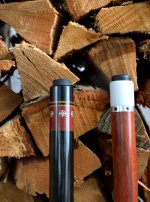I am looking for information on silver used in cue building.
I know that Black Boar and McWorter use it a lot.
I see in some cues silver used as a veneer or outline for ring work or boxes.
I am assuming since most of what i am looking at are not cheap production cues that it isnt silver colored wood or paint.
So is it similar to what is used for jewelry?
Is it a pain for cue makers to work with it?
How much does it add to the cost of a cue? and yes i know that could change depending on the maker.
If there is a previous thread discussing this can you point me in the right direction.
Thank you.
Dan
I know that Black Boar and McWorter use it a lot.
I see in some cues silver used as a veneer or outline for ring work or boxes.
I am assuming since most of what i am looking at are not cheap production cues that it isnt silver colored wood or paint.
So is it similar to what is used for jewelry?
Is it a pain for cue makers to work with it?
How much does it add to the cost of a cue? and yes i know that could change depending on the maker.
If there is a previous thread discussing this can you point me in the right direction.
Thank you.
Dan

